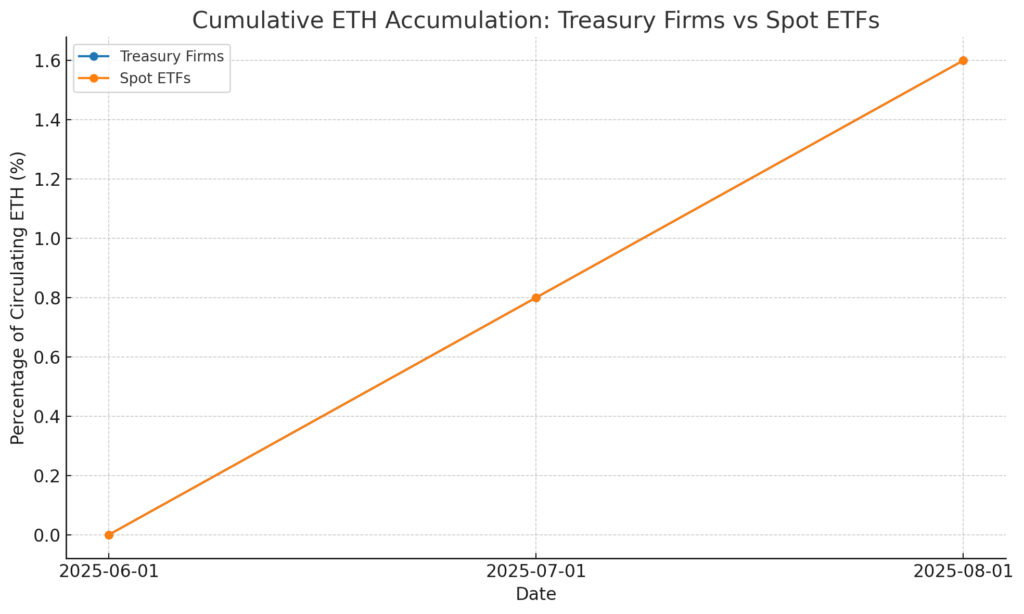
Main Points:
- Standard Chartered highlights NAV multiples for Ethereum treasury firms stabilizing above 1.0.
- Treasury firms offer direct ETH exposure, staking rewards, and DeFi participation, unlike US spot ETH ETFs.
- SharpLink Gaming (SBET) and BitMine Immersion (BMNR) lead the sector with significant ETH holdings.
- Since June 2025, treasury firms have accumulated 1.6% of circulating ETH, matching ETF purchase pace.
- Regulatory developments in the US aim to improve ETF structures, but volatility persists.
- Projections indicate treasury firm holdings could grow to 10% of ETH supply, driven by institutional demand.
1. Standard Chartered’s Perspective
In an August 7, 2025, investor note, Geoffrey Kendrick, Global Head of Digital Asset Research at Standard Chartered Bank, asserted that Ethereum treasury firms present a more compelling investment case than US spot Ethereum ETFs. He observed that the net asset value (NAV) multiples for these publicly traded treasury companies have “normalized” and are now consistently above 1.0, signaling robust demand and valuation discipline.
Kendrick explained that a NAV multiple represents a firm’s market capitalization divided by the dollar value of its ETH holdings. A multiple above 1.0 implies that investors are willing to pay a premium over the underlying ETH value, largely because treasury firms provide additional value through staking rewards and decentralized finance (DeFi) activities—benefits not available to ETF holders.
2. NAV Multiple Normalization
Standard Chartered’s research indicates that before June 2025, many Ethereum treasury firms traded at NAV discounts, reflecting investor uncertainty around token security, regulatory risk, and yield consistency. However, as staking yields stabilized (around 3–5% annually) and DeFi protocols matured, NAV multiples moved above 1.0.
“I see no reason for the NAV multiple to go below 1.0 because these firms are providing regulatory arbitrage opportunities for investors,” Kendrick wrote, reinforcing the thesis that these entities remain an easy “on-ramp” for institutional ETH exposure.
3. Staking and DeFi Advantages
Unlike spot ETH ETFs in the United States—currently restricted from participating in staking or DeFi—treasury firms actively deploy their ETH across validator nodes and lending protocols. This dual-income strategy delivers:
- ETH Price Appreciation: Direct exposure to market movements of ETH.
- Staking Rewards: Annual yields, compounding ETH holdings over time.
- DeFi Yield Farming: Additional returns from liquidity provision and lending.
These combined revenue streams can enhance total investor returns, especially during bullish market cycles.
4. Key Players: SharpLink Gaming and BitMine Immersion
Two prominent names dominate the Ethereum treasury landscape:
- SharpLink Gaming (NASDAQ: SBET): Co-founded by Ethereum co-creator Joe Lubin and backed by ConsenSys, SBET has operated the longest among treasury firms. Its NAV multiple recently rose above 1.0, reflecting regained investor confidence ahead of its Q2 earnings report on August 15, 2025.
- BitMine Immersion (NASDAQ: BMNR): Aiming to accumulate 5% of all ETH, BMNR has rapidly scaled its holdings and now ranks as the largest single ETH treasury firm by supply.
5. Institutional Accumulation Trends
Since June 1, 2025, Ethereum treasury firms have purchased approximately 1.6% of the total ETH in circulation—equal to ETF inflows over the same period. To illustrate:
Chart 1: Cumulative ETH Accumulation by Treasury Firms vs US Spot ETFs
Insert Chart 1 here

This chart shows that both treasury firms and spot ETFs moved in lockstep from June through August, highlighting equivalent institutional appetite. However, the nature of treasury firm holdings—locked in staking contracts and DeFi protocols—suggests a longer-term commitment compared to ETFs, which have experienced volatile same-day inflows and outflows (e.g., a $465 million single-day outflow on August 4, 2025).
6. Regulatory and Market Implications
Recent US Securities and Exchange Commission (SEC) reforms have introduced in-kind creation and redemption for crypto ETFs, aligning their structure more closely with commodity ETFs. Yet, early data reveals that these changes have done little to stabilize ETF flows. In contrast, treasury firms benefit from:
- Regulatory Arbitrage: Public markets outside the US (e.g., Canada, Europe) allow direct ETH staking.
- Jurisdictional Flexibility: Firms domiciled in permissive regions can deploy assets in emerging DeFi sectors.
Investors seeking regulated ETH exposure with yield generation are thus gravitating toward treasury firms even as ETF efficiencies improve.
7. Future Outlook and Projections
Kendrick projects that treasury firms could grow holdings to 10% of circulating ETH—a tenfold increase from current levels—driven by:
- Expanding Institutional Adoption: Pension funds and endowments seeking yield-bearing crypto assets.
- Broader Corporate Reserve Strategies: Firms diversifying treasuries with digital assets for inflation hedging.
- Enhanced Yield Products: New structured products combining equity-like leverage with ETH rewards.
If realized, this growth would position treasury firms as major holders of ETH, potentially influencing market liquidity and price dynamics.
Conclusion
Standard Chartered’s analysis underscores a paradigm shift: publicly traded Ethereum treasury firms are carving out a distinct niche that outperforms traditional US spot ETH ETFs on multiple fronts—NAV stability, staking yield, and DeFi participation. For investors exploring new sources of crypto revenue and practical blockchain utilization, treasury firms represent a compelling avenue to gain efficient, yield-enhanced ETH exposure. As the sector matures and regulatory landscapes evolve, market participants will be watching Q2 earnings reports and subsequent asset accumulation closely to gauge the next phase of institutional engagement.

